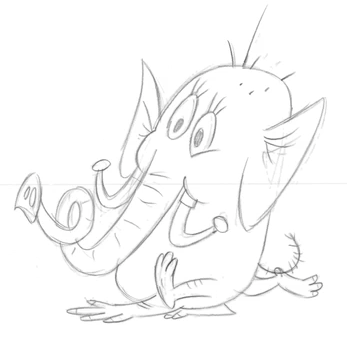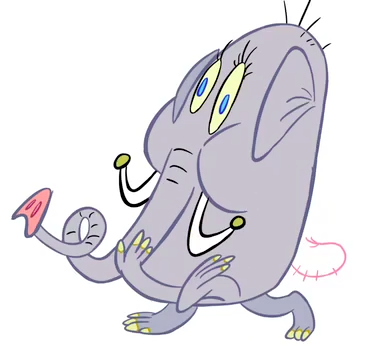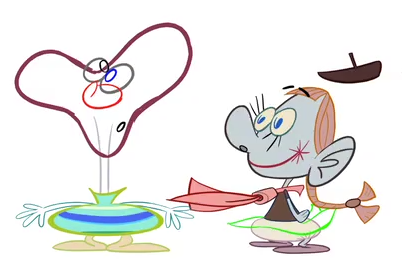
Elephant Pencil Test, animated by animation giant, Mike Kazaleh
When we first started using Harmony, we animated on paper and scanned it in. This was somewhat helpful in making the transition from what we were used to, to animating completely on the computer.

Elephant Final, tweaked in Harmony
Once some of the paper animation was in Harmony, I wanted to see if I could take the actions further. We stretched and squashed the key poses of this elephant and gave the action more emphasis. Jojo did, anyway.

All those wacky BG color card camera effects were done in Harmony. I painted a bunch of BGs in photoshop and kept elements of them on separate layers. Then I got Alex to move them around and dissolve them over each other in Harmony. We also did all the character colors changing using some Harmony tricks.
CLICK THE PIC TO SEE THE BOUNCES

BOUNCING CLIP
Boy's body on left is one drawing squashed and stretched in Harmony,
Girl Body is traditionally animated
 I was experimenting with bounce cycles and wanted to see if I could make a computery bounce look as lively as a straight ahead hand drawn bounce. The boy's body is just one drawing squashed and stretched on a 12x beat in Harmony. It looked flat so I animated some stripes moving up and down around the form of his body and overlapped the up and down action with the body's.
I was experimenting with bounce cycles and wanted to see if I could make a computery bounce look as lively as a straight ahead hand drawn bounce. The boy's body is just one drawing squashed and stretched on a 12x beat in Harmony. It looked flat so I animated some stripes moving up and down around the form of his body and overlapped the up and down action with the body's. The girl's bounce is more customized and completely drawn, so didn't need extra details to make it feel round. I also overlapped her bounce down with his. Her body squashes 1 frame later and doesn't move up as fast. I didn't want them to look robotically in synch.
The girl's bounce is more customized and completely drawn, so didn't need extra details to make it feel round. I also overlapped her bounce down with his. Her body squashes 1 frame later and doesn't move up as fast. I didn't want them to look robotically in synch.
I have longed for a good computer program that would allow me (and others) to do things that were traditional in animation 70 years ago and have brought ideas to software companies many times. I worked with Flash in the early days and tried to get them to put in an exposure sheet and other handy tools. Instead, they came up with an awkward timeline that is practically unreadable-just a mess of indecipherable black dots.
Many animation software companies have told me over the years that they had exposure sheets, but when I actually went to use them, found out that they just looked superficially like ex sheets but didn't function like them.
What's great about how they used to use ex sheets was the way it gave animation directors control over the timing and pacing of the cartoons. Classic ex sheets are marked off by tempos-different tempos depending on the mood and pace of the scenes. 12x tempo is a moderate pacing. 16x is slow. 8x is fast etc... The directors would then go in and mark the key actions and plan the relative spaces between them rhythmically-as if they were writing a musical score or playing the drums.
Then the animators took the large general timing notes and broke the actions down further, into individual frames.
A couple years ago I suggested to the folks at Toonboom that they add in directors' columns and customizable tempo markers that would allow us to plan out the actions according to rhythms like in the old days. Harmony now has this feature, although it is not quite perfect yet.
It is buried in mysterious hidden menus and it is not completely connected to the timeline, so you have to make your own tempo markers in the timeline, which we do for each project.
 The yellow row is a 12x tempo we added to the timeline to match the 12x tempo in the ex sheet.
The yellow row is a 12x tempo we added to the timeline to match the 12x tempo in the ex sheet.It would also be nice if the timing in the directors column could be manipulated and reflected in the corresponding animation column at the same time. Right now though, if you make any changes to the timing you have to change them manually in every column and that's hard to keep track of and amounts to doing it all by hand on paper.
But it is still a very handy tool. You just have to stay organized - which is hard to do once you get on a roll and start animating. I have found through trial and error that it is best to start the project with the layers and timing very organized. It's hard to work straight ahead and then go back and put everything in order, which sucks for me because I like to just get in there and start drawing and hate to have to break a creative flow-which happens all the time because of technical confusions.
CAN HARMONY BRING BACK TRADITIONAL ANIMATION?
Maybe. and I don't just mean hand-drawn when I say "traditional"; I mean all the fundamental atoms of classic animation that have largely been lost since the 60s.
First, there has to be a generation of cartoonists who want to animate and move things in customized, yet controlled ways. - where the way things look and move is a fundamental part of the entertainment, not just an afterthought or a vehicle to mouth inane dialogue written by non-artists.
I think the basic tools are there and am hoping that I get to work with some programmers to take them even further and to make them more artist-friendly and obvious.
The best things about Harmony so far are:
1) Good drawing tools.
This is huge.
If you do not fear drawing, then Harmony is quantum leaps ahead of Flash. Flash is sort of geared for people who can't draw and are comfortable hiding behind all the technical tricks. Harmony might give actual artists back their rightful place at the top of the animation heap. Maybe - if other factors also go our way.
The Harmony brushes are much smoother and more accurate than the tortuously disobedient and ragged Flash brushes.
They take a bit of getting used to but after some practice, you can draw and animate almost clean - and with thick and thin lines.
2) Instant playback - allows you to learn faster
You can play back your animation instantly and loop cycles and make modifications quickly. (It'd be great if the loop function also worked when you were inbetweening and connecting a cycle, but they haven't thought of that yet I guess. I'll suggest it to them).
In the 1930s when animators were on their fastest learning curve, they didn't have this advantage at all. They had to shoot pencil tests and then wait at least a day to see what they did. If it looked crummy, they'd have to go back and try to figure out how to improve it by trial and error.
Most studios didn't even do pencil tests, so animators had to sometimes wait months to see what they did and whether it worked or not. Even with this disadvantage animators improved themselves and the whole medium faster than at any point in history since. How did they do it?
They were smarter and more logical about the process. They animated everything to tempos and thus knew that their actions would play rhythmically and would that important actions would have emphasis and relate to each other.
Classic animators also learned the art from the ground floor up. They didn't start as storyboard artists or designers being completely ignorant of how animation actually works.
An artist would start by cleaning up and inbetweening the work of a more experienced animator and gradually absorb his skills. If he was good, he might become a full-fledged animator on his own and then add add his own style and touches. Other animators in turn would benefit from each other's progress. This doesn't happen anymore.
THEY ANIMATED HERE-we need a program that allows this to happen again. I think Harmony could do it if it continues to evolve and gets easier to use.
Most animation today is done either overseas on a soulless assembly line or in Flash by moving around puppet drawings. Not very many people today ever have the opportunity to learn how animation really works. Many people think you make animation by writing a script and then sending it to Korea and waiting for 6 months it to come back moving as if by magic. Then everyone pats themselves on the back and says "See what we made?" When they didn't actually make anything. They just vaguely described something and commanded someone in another land to make it for them.
I'll tell you the only thing Flash is good for. It expands your vocabulary. It's like the Rosetta Stone of cursing.
3) Ex Sheets with tempo markers
Having tempo markers in Harmony's ex sheets allows you to pre-plan your actions so that they feel good. This helps you learn timing faster than the classic animators ever could have. To me, the beat is every bit as important to animated cartoons as it is to music. it's part of the structure and emphasis of the art. Without a beat, you just have meandering mushy actions, each as unimportant as the next.
4) Combining Traditional With Digital Techniques
Whereas Flash tends to guide you towards sliding puppets around the screen, Harmony is more versatile. You can jump back and forth between hand-drawn animation and computer tricks while disguising the computer tricks so they look less robotic than in Flash.
5) Inking and Painting
Inking and Painting is pretty easy in Harmony.
You can do colored lines quickly and you can later change the color of a line or fill on a character all in one shot. You don't have to go and individually recolor every single frame.
I wish they had a separate ink and paint program just so I could farm out the clean up and coloring of the cartoons to artists who want to work their way up the creative food chain. Maybe that will come next - a junior harmony program, for apprentices.
If that existed we could have virtual studios around the world and directors with individual styles could have a much larger talent pool to work with. As readers of my blog know, I have many young cartoonists from all over who have a feel for cartoony styles like mine and who practice by inking and cleaning up my rough drawings. It would be great if I could hire them to help me do these projects and not have to up and move to LA at huge expense (and overhead for the studio).
It would also be a way for cartoonists and animators to learn the important fundamental skills on the job again.
As it is now they'd have to have Harmony (along with Flash, Photoshop, Illustrator, Painter and all the other big programs they probably have already) and if they get the big package with all the bells and whistles, it'd pretty challenging to figure out what's what right off the bat.
But I'm hoping these things will come and that we will again have a thriving evolving artform that also values a diversity of styles and approaches rather than the handful of corporate assembly line animated products we have today.
HARMONY'S WEBSITE
I'd be curious to know your experiences if you are animating in Harmony. You probably know some tricks I haven't discovered yet.



